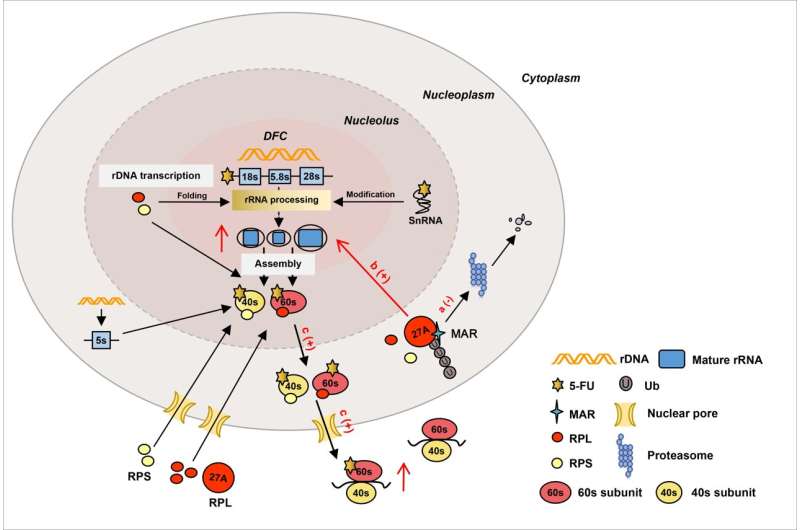This article has been reviewed according to Science X's editorial process and policies. Editors have highlighted the following attributes while ensuring the content's credibility:
fact-checked
trusted source
proofread
Martynoside found to rescue 5-fluorouracil-impaired ribosome biogenesis by stabilizing RPL27A

Myelotoxicity is the primary dose-limiting effect of the commonly used chemotherapeutic agent 5-fluorouracil (5-FU), which may endanger the life of the patient. Ribosome biogenesis is a key pathway regulating hematopoietic stem cells, and its disruption is deleterious to hematopoiesis. Treatment with 5-FU impairs ribosome biogenesis and causes hematologic toxicity.
Martynoside (MAR) is a phenylpropanoid glycosidic compound that is found in blood-nourishing Chinese herbs and exhibits multi-lineage protective effects in mice with 5-FU-induced myelosuppression. The scientists have validated that MAR does not compromise the anticancer effects of 5-FU on melanoma or colon cancer, supporting the clinical significance of MAR in alleviating the hematologic toxic effects of chemotherapy.
Nevertheless, the direct molecular targets of MAR have not yet been reported, and its mechanism of action is not well understood. Hence this study, which was led by Prof. Ren Sun (Westlake University) and research fellow Yushen Du (Cancer Institute, the Second Affiliated Hospital, Zhejiang University School of Medicine).
Identification of drug targets is fundamental to the study of the mechanisms of action and to the development of next-generation drugs with improved efficacy and reduced toxic side effects. Recently developed md-LED (mRNA display with a library of even distribution) method, integrating human exon library construction, mRNA display, and high-throughput sequencing, has been proven to be a semi-quantitative and low-labor-intensive method for the investigation of protein interactions.
This platform offers several advantages over the commonly used affinity-purification/mass spectrometry (AP-MS) method, including avoiding high false-positive interactions and providing insight into potential binding domains.
First, the research team adopted the md-LED method to probe proteins interacting with MAR. They found that ribosomal protein L27a (RPL27A) was the key binding target protein for MAR and MAR specifically bound the exon 4,5-encoded region of RPL27A with a moderate dissociation constant (Kd) of 16.6 μmol/L. Then, R87 and K116 were identified as the key amino acids responsible for the interaction.
Furthermore, both in vivo and in vitro studies indicated that MAR attenuated the 5-FU-induced reduction in RPL27A protein level via inhibiting RPL27A ubiquitination at K92 and K94.
Since ribosomal proteins play a crucial role in ribosome biogenesis, these findings prompted scientists to investigate the role of MAR and RPL27A in the regulation of mature rRNA abundance and global ribosome protein abundance in 5-FU-treated cells, as well as ribosome function. They found that MAR successfully restored the compromised mature rRNA abundance across various 5-FU-treated cell models. Notably, MAR treatment led to an increase in total ribosome protein levels, increased ribosome abundance, and improved ribosome function.
In summary, these results suggest that MAR may rescue 5-FU-impaired ribosome biogenesis by binding and stabilizing RPL27A to recover the bone marrow hematopoietic function destroyed by 5-FU. In addition, this study validated that the md-LED method, as PCR amplification-based method, may be complementary to the MS-based strategy for probing drug-protein interactions.
The paper is published in the journal Science Bulletin.
More information: Mengying Hong et al, Martynoside rescues 5-fluorouracil-impaired ribosome biogenesis by stabilizing RPL27A, Science Bulletin (2023). DOI: 10.1016/j.scib.2023.07.018
Provided by Science China Press




















